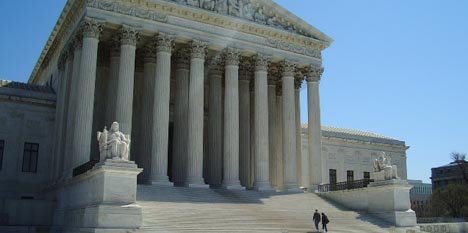[dc]A[/dc]fter a lengthy legal battle, the U.S. Supreme Court has ruled unanimously (see Reed v. Gilbert , decided June 18, 2015) that a town cannot bar church signs when it allows similar signs promoting political or ideological viewpoints. In 2007, Good News Community Church sued Gilbert, Arizona, when the town enforced a law banning the church from posting road signs the day before services began.
The town ordinance prohibited the display of outdoor signs without permits but did provide for 23 exemptions to the rule, including “Ideological Signs” which were designed to “communicate a message or dieas” could be up to 20 square feet and had no placement or time restrictions. “Political Signs” could be up to 32 square feet but could only be displayed during an election season. “Temporary Directional Signs” could be up to six square feet and could not be posted more than 12 hours before or one hour after an event.
The Church, pastored by Clyde Reed, met at various temporary locations around the town and so he would post the signs early each Saturday morning indicating the location and time of the next service and he would remove them after services on Sundays. The church was cited for violating the sign ordinance.
Until the case reached the Supreme Court, lower courts had ruled that the ordinance was constitutional because it treated all non-commercial groups equally and the ordinance did not take viewpoint into consideration. The town had argued that the restrictions on temporary signs were reasonable, and the 9th Circuit Court of Appeals affirmed the ordinance on the basis that it was “content neutral” and met the intermediate scrutiny standard.
The Supreme Court applied “strict scrutiny” and ruled that the ordinance was not content neutral since it distinguished between political, ideological, and religious speech on the basis of the messages on the signs and gave each type of sign different restrictions.
The ordinance was “presumptively unconstitutional” and the government failed to demonstrate that it was “narrowly tailored” to serve a compelling state interest. The Supreme Court disagreed with the 9th Circuit’s theory that the ordinance enforcement was constitutional because the town’s enforcement was not based on disagreement with the message on the sign. The application of the strict scrutiny standard to ordinance enforcement, the Supreme Court ruled, does not depend on what the governing body thinks about the speech. The courts must evaluate the issue based on whether (1) the law is content based on its face and (2) whether the purpose and justification for the law are content based.
Analysis:
This case is consistent with the reasoning with the Supreme Court’s earlier decision this year in EEOC v Abercrombie and Fitch which found that an employer does not have to intend to discriminate in order to be found to be discriminating against religion. Here the town did not intend to discriminate against the church by prohibiting signage outside of certain hours but it had an effect of prohibiting the sign, thus adversely affecting the church.
On a separate note, in Employment Division v. Smith (1990), the Supreme Court ruled that a law is constitutional if it is facially neutral toward religion and generally applied. In Reed v. Gilbert, the Court has tightened up the definition of what it means for a law to be facially neutral. Here, by favoring political speech over religious speech by treating the signs differently based on content, the town of Gilbert invoked the strict scrutiny standard which the ordinance failed to reach.
Reed v. Gilbert – http://www.supremecourt.gov/opinions/14pdf/13-502_9olb.pdf – Decided June 18, 2015

